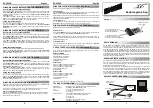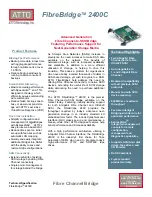
10 FIFO Operation
The MPAP-200 is equipped with 1024-byte external FIFOs in the transmit and receive
data paths. These FIFOs are implemented as extensions of the SCC's small internal FIFOs. They
have been designed to be as transparent as possible to the software operating the MPAP-200. By
using these FIFOs, it is possible to achieve high data rates despite the MPAP-200 not supporting
DMA.
The FIFOs are disabled by default after card insertion, power-up, or a socket reset.
10.1 Enabling and disabling the FIFOs
The FIFOs must be enabled or disabled as a pair. It is not possible to operate only the
transmit FIFO or only the receive FIFO. The FIFOs are enabled by setting bit 2 of the
Configuration Register to a logic 1. The FIFOs are disabled by clearing the same bit.
10.2 Accessing the FIFOs
When the FIFOs are enabled, they are accessed through either the channel A or channel B
SCC Data Port address. Writing to Base+0 or Base+2 will cause a byte to be written into the
transmit FIFO. Reading from Base+0 or Base+2 will cause a byte to be read from the receive
FIFO.
The FIFOs cannot be accessed if they are disabled. If the FIFOs are disabled, reads or
writes of the SCC Data Ports access the receive or transmit register of the appropriate SCC
channel. Any control port writes of SCC write register 8 (transmit buffer) or control port reads
of SCC read register 8 (receive buffer) directly access the SCC, whether the FIFOs are enabled or
not.
10.2.1 Transmit FIFO
The transmit FIFO always services the transmitter of channel A of the SCC. If the FIFOs
are enabled, an I/O write to either SCC Data Port (channel A or channel B) will write a byte to
the transmit FIFO. If the FIFOs are not enabled, an I/O write to the SCC Data Port will instead
write directly to the internal transmit buffer of the specified channel of the SCC.
36
















































